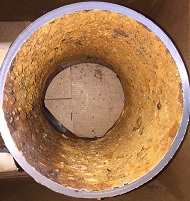FOR IMMEDIATE RELEASE

“Physical and Chemical Characterization of Urban Grime Sampled from Two Cities”
ACS Earth and Space Chemistry
Many city surfaces are coated with a layer of soot, pollutants, metals, organic compounds and other molecules known as “urban grime.” Chemical reactions that occur in this complex milieu can affect air and water quality. Now, researchers reporting in ACS Earth and Space Chemistry have taken a closer look at urban grime collected from two U.S. cities, revealing for the first time that the material absorbs sunlight and therefore might participate in photochemical reactions.
Scientists have previously analyzed lab-prepared urban grime, as well as samples collected from cities, but they still don’t have a complete understanding of what’s in the material, or how it varies by location. Some components can react with other molecules in the grime or air, which could affect what gets released into the atmosphere or into the water when it rains. To better understand these processes, Tara Kahan and colleagues wanted to investigate the physical properties, light absorption and composition of urban grime samples collected from Syracuse, New York, and Scranton, Pennsylvania.
The researchers collected samples of urban grime from Syracuse by placing vertical quartz plates outdoors for 30 days and then analyzed the surfaces. Although urban grime was long thought to be predominantly a film, the samples showed collections of particles, rather than a uniform film, consistent with evidence from other recent studies. In different experiments, the team scraped grime from wet exterior surfaces of windows in both cities and analyzed their compositions. The results were similar to those reported from other cities in Canada and Europe, but there were differences in specific ions. For example, higher chloride levels were found in North American cities, which could be from the use of road salt in the winter, whereas higher sulfate levels were reported in some European cities, likely because of coal combustion. The team also observed that urban grime absorbed light at wavelengths found in sunlight, which suggests that the sun could speed up or slow down chemical reactions that affect air and water quality in cities.
The authors acknowledge funding from the Oak Ridge Associated Universities Ralph E. Powe Junior Faculty Enhancement Award, the Alfred P. Sloan Foundation Chemistry of Indoor Environments program and the Canada Research Chairs program.
To automatically receive press releases from the American Chemical Society, contact newsroom@acs.org.
Note: ACS does not conduct research, but publishes and publicizes peer-reviewed scientific studies.
Note: ACS does not conduct research but publishes and publicizes peer-reviewed scientific studies.




